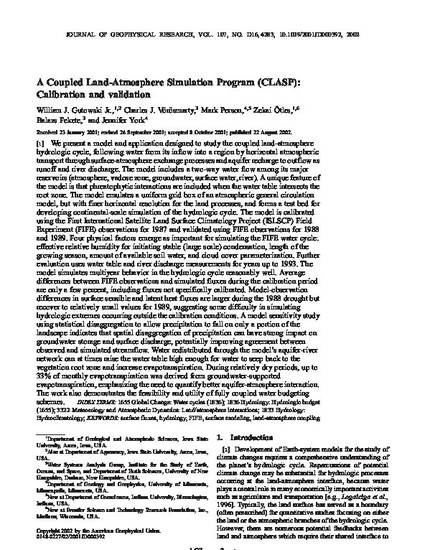
We present a model and application designed to study the coupled land-atmosphere hydrologic cycle, following water from its inflow into a region by horizontal atmospheric transport through surface-atmosphere exchange processes and aquifer recharge to outflow as runoff and river discharge. The model includes a two-way water flow among its major reservoirs (atmosphere, vadose zone, groundwater, surface water, river). A unique feature of the model is that phreatophytic interactions are included when the water table intersects the root zone. The model emulates a uniform grid box of an atmospheric general circulation model, but with finer horizontal resolution for the land processes, and forms a test bed for developing continental-scale simulation of the hydrologic cycle. The model is calibrated using the First International Satellite Land Surface Climatology Project (ISLSCP) Field Experiment (FIFE) observations for 1987 and validated using FIFE observations for 1988 and 1989. Four physical factors emerge as important for simulating the FIFE water cycle: effective relative humidity for initiating stable (large scale) condensation, length of the growing season, amount of available soil water, and cloud cover parameterization. Further evaluation uses water table and river discharge measurements for years up to 1993. The model simulates multiyear behavior in the hydrologic cycle reasonably well. Average differences between FIFE observations and simulated fluxes during the calibration period are only a few percent, including fluxes not specifically calibrated. Model-observation differences in surface sensible and latent heat fluxes are larger during the 1988 drought but recover to relatively small values for 1989, suggesting some difficulty in simulating hydrologic extremes occurring outside the calibration conditions. A model sensitivity study using statistical disaggregation to allow precipitation to fall on only a portion of the landscape indicates that spatial disaggregation of precipitation can have strong impact on groundwater storage and surface discharge, potentially improving agreement between observed and simulated streamflow. Water redistributed through the model's aquifer-river network can at times raise the water table high enough for water to seep back to the vegetation root zone and increase evapotranspiration. During relatively dry periods, up to 33% of monthly evapotranspiration was derived from groundwater-supported evapotranspiration, emphasizing the need to quantify better aquifer-atmosphere interaction. The work also demonstrates the feasibility and utility of fully coupled water budgeting schemes.
Available at: http://works.bepress.com/william-gutowski/43/

This article is from Journal of Geophysical Research: Atmospheres 107 (2002):ACL 3-1, doi:10.1029/2001JD000392. Posted with permission.